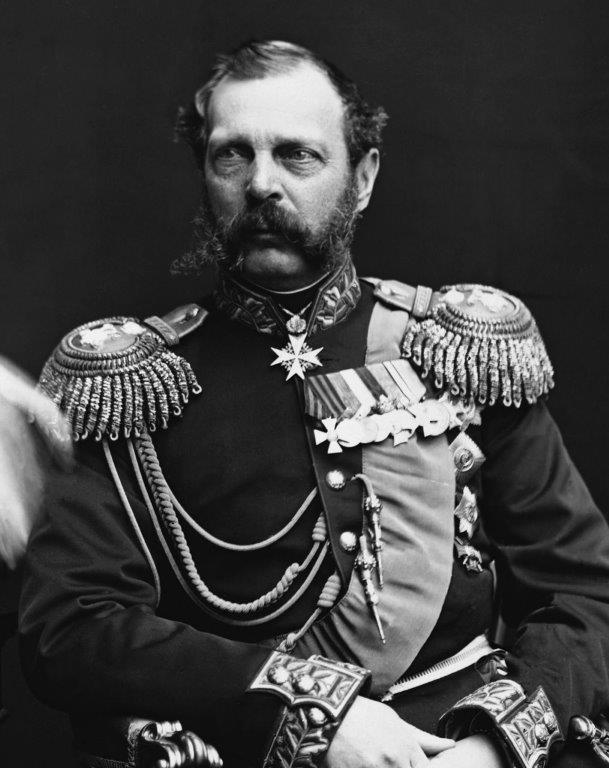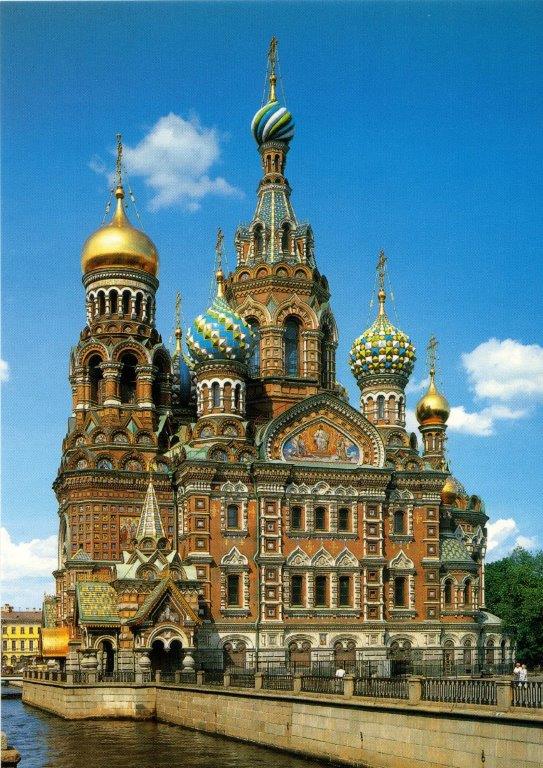November 4 - 10, 2018: Issue 382
THE CHURCH ON SPILLED BLOOD - 2005
THE CHURCH ON SPILLED BLOOD - 2005
By George Repin
Alexander II, Tsar of Russia, after surviving five earlier attempts on his life, was assassinated beside the Griboedov Canal in St Petersburg on 13 March (OS 1 March) 1881. He survived the explosion of a first bomb, safe in his armoured carriage, but got out to check on the condition of injured accompanying Cossacks and was fatally wounded by a second bomb.

Tsar Alexander II.
Born 29 April, 1818. Died 13 March, 1881.
In history he is referred to as Alexander the Liberator because of his most significant reform, namely the emancipation of Russia’s serfs. The Emancipation Reform of 1861, which effectively abolished serfdom throughout the Russian Empire, was the first and most important of a number of liberal reforms passed during his reign. Before the abolition of serfdom Russian peasants were tied to the land on which they lived, served their landlords, did not have freedom of movement and were unable to own land themselves. Under the Emancipation Reform serfs gained the full rights of free citizens.
Unlike his ultra conservative autocratic father Alexander realised that Russia needed other reforms. He reorganised the judicial system, introduced trial by jury, set up elected local judges, abolished corporal punishment, promoted local self-government, loosened censorship, ended some privileges of the nobility and promoted universal education.
Although the emancipation legislation was well planned, in practice the reform did not work smoothly. Despite their newly acquired freedom the life of the serf remained grim in many respects.
While it might have been expected that Alexander II’s reforms would have created a freer, more liberal climate in the country the reforms were not extensive enough for the radically-minded members of society who persisted with their aim, ultimately successful, to assassinate the Tsar. As an irony of fate Alexander was proposing additional parliamentary reforms and, on the very day he was assassinated, had signed a document accepting the project of Minister Loris-Melikov which would have given Russia a constitution.
Alexander II’s son, his successor as Alexander III, was a very different man from his father. He immediately stopped the development of a constitution, and his internal reforms were aimed to reverse the liberalisation that his father had initiated. He believed that remaining true to Russian Orthodoxy, Autocracy (with the blessing of God) and Nationality would save Russia from revolutionary agitators.
Construction of The Church on Spilled Blood (also known as The Church of the Savior on Spilled Blood) began in 1883, on the Griboedov Canal where Alexander II was assassinated two years earlier. It was intended by Alexander III as a memorial for his father. It was completed by his son, Tsar Nicholas II in 1907. Funding was provided by the Imperial family with help from donors.
Architecturally the church is quite different from the predominantly Baroque and Neoclassical buildings of St. Petersburg. Instead it harks back to medieval Russian architecture, intentionally resembling St. Basil’s Cathedral in Moscow and the 17th Century churches in Yaroslavl. A riot of colour, the overall effect is created by the imaginative juxtaposition of materials. Inside, more than 20 types of minerals, including jasper, rhodonite, porphyry and Italian marble are lavished on the mosaics of the iconostasis, icon cases, canopy and floor. The church contains 7500 sq meters of mosaics.

The Church on Spilled Blood on the Griboedov Canal, St. Petersburg
In the aftermath of the Russian revolution the church was ransacked and looted. It was closed in 1932 by the Soviet Government. It was badly damaged during and after the siege of Leningrad. Only in August 1997, after 27 years restoration, was it reopened and is now a major tourist attraction in St. Petersburg. It has not been reconsecrated.
Alexander II died at the age of 63 before he could put in place constitutional change and introduce other reforms in response to the pressure building up in Russia. He died before his reforms were deeply embedded and difficult for his ultra-conservative son, Alexander III, to reverse. The reign of Alexander III was one of rabid reaction. The press was again under strict censorship and the secret police more active than ever. Workers began to get organized and opposition was growing. Had Alexander II lived to implement reforms the appalling events of the next thirty years, including “Bloody Sunday” on 9th January, 1905, culminating in the October Revolution in 1917 might have been averted.
The estimated 80 million Russians whose deaths are attributed to Stalin and his economic, agricultural and political policies - and personal vendettas might have been averted. The course of history might have been different had it not been for the second bomb on the Griboedov Canal.
Previous Reflections by George Repin
The Nineteen Thirties Remembering Rowe Street The Sydney Push Saturday Night at the Movies Shooting Through Like A Bondi Tram A Stop On The Road To Canberra City Department Stores - Gone and Mostly Forgotten An Australian Icon - thanks to Billy Hughes Crossing The Pacific in the 1930s Hill End The Paragon at Katoomba Seafood In Sydney How Far From Sydney? Cockatoo Island Over The Years The Seagull at the Melbourne Festival in 1991 Busby's Bore The Trocadero In Sydney Cahill's restaurants Medical Pioneers in Australian Wine Making Pedal Power and the Royal Flying Doctor Service Pambula and the Charles Darwin Connection Gloucester and the Barrington Tops A Millenium Apart Have You Stopped to Look? Gulgong Il Porcellino Olympia Durham Hall Sargent's Tea Rooms Pie Shops and Street Photographers The Ballet Russes and Their Friends in Australia Hotels at Bondi Alma Ata Conference - 1978 Keukenhof - 1954 The Lands Department Building and Yellowblock Sandstone The Goroka Show - 1958 A Gem On The Quay Staffa The Matson Line and Keepsake Menus Kokeshi Dolls The Coal Mine At Balmain The Hyde Park Barracks The Changing Faces Of Sydney From Pounds and Pence to Dollars and Cents Nell Tritton and Alexander Kerensky Making A Difference In Ethiopia William Balmain J C Bendrodt and Princes Restaurant Azzalin Orlando Romano and Romano's Restaurant Waldheim Alcohol in Restaurants Before 1955 King Island Kelp The Mercury Theatre Around Angkor - 1963 Angkor Wat 1963 Costumes From the Ballets Russe Clifton at Kirribilli Chairman Mao's Personal Physician The Toby Tavern The MoKa at Kings Cross The Oceaographic Museum in Monaco The Island of Elba Russian Fairy Tale Plates Meteora Souda Bay War Cemetery Barrow, Alaska Cloisonné Tripitaka Koreana Minshuku The Third Man Photographs and Memories Not A Chagall! Did You Listen? Did You Ask? Napier (Ahuriri, Maori) New Zealand Borobudur Ggantija Temples Plumes and Pearlshells Murano University of Padua Ancient Puebloe Peoples - The Anasazi Pula The Gondolas of Venice Cinque Terre Visiting the Iban David The Living Desert Bryce Canyon National Park Aphrodisias The Divine Comedy Caodaism Sapa and local Hill People A Few Children Cappadocia Symi Jean-Marie Tjibaou Cultural Centre Aboriginal Rock Art on Bigge Island ANZAC Cove (Ari Burnu) 25 April, 1997 Hotere Garden Oputae Children of the Trobriand Islands Page Park Market - Rabaul Rabual Kotor, Montenegro Galleries of Photographs I Lascaux Galleries of Photographs II The Cathedral of St. James – Šibenik, Croatia Ivan Meštrović - Sculptor Delphi Gallery of Photographs III The Handicrafts of Chiang Mai Raft Point San Simeon - "Hearst Castle" Floriade - The Netherlands - 1982 Russian New Year Mycenae "Flightseeing" Out Of Anchorage Alaska The White Pass and Yukon Route Totem Poles Tivkin Cemetery Krka National Park - Croatia Tavistock Square and the BMA Orthodox Easter Wieliczka Salt Mine A Walk on Santorini Indonesian Snapshots Ephesus - The Library of Celsus Ephesus - Some Places Of Interest Waimea Canyon and the Kalalau Valley United Nations Headquarters 1958 A Miscellany of Flower Images Gardens Bath St. David's In Wales Zion National Park Nicholas Himona - Artist Kraków Lilianfels Collonges-La-Rouge Gingerbread Houses Cape Sounion Delos Wroclaw Colonial Williamsburg Gruyères Strasbourg Coventry Cathedral The Roman Theatre at Aspendos Turkish Carpets The Duomo of Orvieto Rovinj The City Walls of Dubrovnik Monaco - Snapshots Bonifacio, Corsica Autumn in New England USA The Great Ocean Road Pompeii Didyma Lawrence Hargrave 1850-1915 The Corinth Canal Malta Snapshots of Amsterdam Café Central - Vienna The Forbidden City - Beijing, China A Ride on the Jungfrau Railway - 1954 Snapshots in the Highlands of Scotland 1954 Must See Sights in Paris - 1954 Corfu Reflections On the Nineteen Thirties The Gold Souk in Dubai Stromboli Ha Long Bay - Vietnam Lake Argyle The Bungle Bungle Range Langgi Inlet, W.A. White Cliffs, NSW - 1990 Sturt National Park - May, 1990 A Few Statues and Water Spouts The Dodecanese Archipelago Rhodes Lindos
Copyright George Repin 2018. All Rights Reserved.